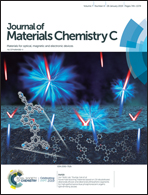Ferroelectric transitions in silver niobate ceramics†
Abstract
Silver niobate (AgNbO3)-based dielectric materials show great application potential in pulse power energy storage systems due to their high energy storage density. However, a fundamental understanding of this important lead-free system has remained controversial ever since its discovery in 1958. In the present study, a comprehensive investigation was performed via analyzing the chemical structure and physical properties of AgNbO3-based dielectric materials. The results confirm that the dielectric anomalous behavior occurring at ∼170 °C, which has been considered as the freezing temperature/transition of the antipolar dipoles (Tf) in early publications, actually originates from a phase transition between the non-centrosymmetric weakly polar and centrosymmetric non-polar phases. Moreover, the weakly polar phase exhibiting antipolar ordered behavior is proposed to be ferrielectric and is responsible for the strong field-induced double-like polarization hysteresis. The dielectric relaxor behavior at ∼70 °C, which was attributed to the M1 ↔ M2 transition in early studies, was further demonstrated to be intimately correlated with the presence of local ferroelectric-type polar domains in a weakly polar/ferrielectric phase. The observed weak remnant polarization within double-like polarization hysteresis under strong field cycles is proposed to mainly originate from the polarization contributed by the residual strong field-induced ferroelectric phase.



 Please wait while we load your content...
Please wait while we load your content...